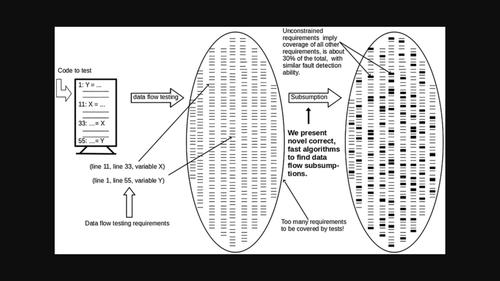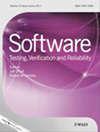论数据流测试中的包容关系
IF 1.5
4区 计算机科学
Q3 COMPUTER SCIENCE, SOFTWARE ENGINEERING
引用次数: 0
摘要
数据流测试创建了定义-使用(DU)关联的测试需求,其中定义是将值赋给变量的程序位置,而使用是访问该值的位置。数据流测试是昂贵的,主要是因为测试需求的数量。幸运的是,许多DU关联在某种意义上是冗余的,如果覆盖了一个测试需求(例如节点,边和DU关联),则保证其他DU关联也被覆盖。这种关系被称为包容。因此,测试人员可以通过只覆盖不包含在其他测试需求中的DU关联来节省资源。尽管这有可能显著降低数据流测试的成本,但它的应用仍然存在障碍。正确有效地找到数据流假设一直是一个难以实现的目标;需要评估数据流假设所带来的节省和发现这些节省的费用;并且需要验证简化的DU关联集的故障检测能力以及数据流测试相对于节点和边缘覆盖的优势。本文提出了解决这些问题的新方法。我们提出的算法可以正确地找到数据流假设,并且比以前的算法成本渐近降低。我们提出的经验数据表明,数据流包容在减少待测试的DU关联数量方面是有效的,并且可以在规模上发现。此外,我们发现使用减少的DU -关联使故障检测能力降低了不到2%,数据流测试增加了节点和边缘覆盖之外的测试价值。本文章由计算机程序翻译,如有差异,请以英文原文为准。

On subsumption relationships in data flow testing
Data flow testing creates test requirements as definition‐use (DU) associations, where a definition is a program location that assigns a value to a variable and a use is a location where that value is accessed. Data flow testing is expensive, largely because of the number of test requirements. Luckily, many DU‐associations are redundant in the sense that if one test requirement (e.g. node, edge and DU‐association) is covered, other DU‐associations are guaranteed to also be covered. This relationship is called subsumption. Thus, testers can save resources by only covering DU‐associations that are not subsumed by other testing requirements. Although this has the potential to significantly decrease the cost of data flow testing, there are roadblocks to its application. Finding data flow subsumptions correctly and efficiently has been an elusive goal; the savings provided by data flow subsumptions and the cost to find them need to be assessed; and the fault detection ability of a reduced set of DU‐associations and the advantages of data flow testing over node and edge coverage need to be verified. This paper presents novel solutions to these problems. We present algorithms that correctly find data flow subsumptions and are asymptotically less costly than previous algorithms. We present empirical data that show that data flow subsumption is effective at reducing the number of DU‐associations to be tested and can be found at scale. Furthermore, we found that using reduced DU‐associations decreased the fault detection ability by less than 2%, and data flow testing adds testing value beyond node and edge coverage.
求助全文
通过发布文献求助,成功后即可免费获取论文全文。
去求助
来源期刊

Software Testing Verification & Reliability
工程技术-计算机:软件工程
CiteScore
3.70
自引率
0.00%
发文量
34
审稿时长
>12 weeks
期刊介绍:
The journal is the premier outlet for research results on the subjects of testing, verification and reliability. Readers will find useful research on issues pertaining to building better software and evaluating it.
The journal is unique in its emphasis on theoretical foundations and applications to real-world software development. The balance of theory, empirical work, and practical applications provide readers with better techniques for testing, verifying and improving the reliability of software.
The journal targets researchers, practitioners, educators and students that have a vested interest in results generated by high-quality testing, verification and reliability modeling and evaluation of software. Topics of special interest include, but are not limited to:
-New criteria for software testing and verification
-Application of existing software testing and verification techniques to new types of software, including web applications, web services, embedded software, aspect-oriented software, and software architectures
-Model based testing
-Formal verification techniques such as model-checking
-Comparison of testing and verification techniques
-Measurement of and metrics for testing, verification and reliability
-Industrial experience with cutting edge techniques
-Descriptions and evaluations of commercial and open-source software testing tools
-Reliability modeling, measurement and application
-Testing and verification of software security
-Automated test data generation
-Process issues and methods
-Non-functional testing
 求助内容:
求助内容: 应助结果提醒方式:
应助结果提醒方式:


